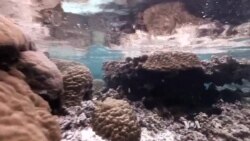A marine biologist and his novelist son have teamed up to engage readers in the drama and conflict of life in the ocean.
The world's oceans are overfished and polluted with climate-changing gases that make the waters acidic and less productive. That reality is the uderlying theme running through The Extreme Life of the Sea.
“By looking at the extremes of what life can do, we can surmise what it is capable of,” said novelist and co-author Tony Palumbi.
Together with his father Steve, a marine scientist at Stanford University, the two focus on the creatures that survive in that extreme world.
“They are constantly eating one another and competing with one another and trying to swim through a really dense medium and then have crashing waves or incredible heat or incredible cold," Steve said. "Those extremes are outside our normal experience, but the ocean is full of life. It has the most diversity on the planet, millions of species. Every corner of the ocean has thriving life in it.”
Twenty million years ago, the giant megalodon shark, with dagger-like teeth in an enormous two-meter-wide jaw, ruled the ocean.
“How do you grow something that is three times sharper than a razor blade?" said Steve. "And they not only grow them, but they grow lots of them because as they get dull, they just discard them."
In The Extreme Life of the Sea, all is not as it appears. The book includes the story of a bowhead whale whose real age even surprised the Native Americans that hunted it.
“In the course of processing this whale they found in a scar on its back a brass harpoon head, the sort of thing that hadn’t been cast at a whale in 100 years," Tony said. "Yet there it was proof positive that this whale had been swimming 100 years before.”
The oldest-known creature on the planet is a deep-sea black coral in Hawaii that was alive more than 4,200 years ago, when the pyramids of Egypt were being built.
And the fastest, says Steve, is the sail fish, which races after prey at speeds greater than 60 kilometers per hour.
“They’ve got a 1/30th of a second before hitting the fish and gulping it down," he said. "Their brains have to work very fast. Their eyes have to work very fast. But they are cold blooded animals and the ocean is cold. So in order to keep their eyes working and their brains working too, they heat them up. They have heaters on the back of their eyes and they have heaters on the tops of their brains and by heating their eyes and brain they can actually see and react fast enough to eat at those speeds."
A survivor in extreme cold is the black fin ice fish that lives in Antarctica. It has developed an anti-freeze protein to keep its blood from freezing. And the Pompeii worm lives in both extreme heat and cold at the same time in a hydrothermal sea vent.
“Its head is living in ice water temperatures but an inch [2.54 centimeters] away its tail is up against what’s called a black smoke or chimney of hot water," Steve said. "And that tail is living an inch away at hot tea temperatures.”
These curious critters are but a sampling the ocean's denizens, whose diversity remains largely unexplored and whose habitat is under assault from overfishing, pollution and climate change. The oceans will always be alive, but it's a question of what will be in them.
“We’re looking at a potential future where the oceans are filled with algae rafts and tremendous amounts of jellyfish and sea cucumbers and the sort of squishy, scummy things and perfectly valid things on Earth are not the sort of things that we like,” Tony said.
The ocean can thrive. One solution is to expand marine sanctuaries that limit human activity. What’s missing, Steve says, is the political will to take action, but that can change with engaged and concerned citizens.
“Instead of looking at this life as something that we can just take like mine of fishes, it should be our partner in allowing the oceans and useful for us," Steve said. "So it’s that partnership that we are trying to reestablish here. Then maybe we’ll get people to care a little bit more about what the ocean is doing.”
The future of the ocean, the authors say, rests in our hands, and we must become better stewards to protect it and ourselves.











